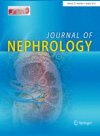The effect of different consensus definitions on diagnosing acute kidney injury events and their association with in-hospital mortality
Abstract
Background
Due to the existence of different AKI definitions, analyzing AKI incidence and associated outcomes is challenging. We investigated the incidence of AKI events defined by 4 different definitions (standard AKIN and KDIGO, and modified AKIN-4 and KDIGO-4) and its association with in-hospital mortality.
Methods
A total of 7242 adult Greek subjects were investigated. To find the association between AKI stages and in-hospital mortality, we considered both the number of AKI events and the most severe stage of AKI reached by each patient, adjusted for age, sex, and AKI staging, using multivariable logistic regression. To predict mortality in AKI patients, as defined by the four definitions, a classification task with two prediction models (random forest and logistic regression) was also conducted.
Results
The incidence of AKI using the KDIGO-4 was 6.72% for stage 1a, 15.71% for stage 1b, 8.06% for stage2, and 2.97% for stage3; however, these percentages for AKIN-4 were 11%, 5.83%, 1.75%, and 0.33% for stage 1a, stage 1b, stage 2, and stage 3, respectively. Results showed KDIGO-4 is more sensitive in detecting AKI events. In-hospital mortality increased as the stage of AKI events increased for both KDIGO-4 and AKIN-4; however, KDIGO-4 (KDIGO) had a higher odds ratio at a higher stage of AKI compared to AKIN-4 (AKIN). Lastly, when using KDIGO, random forest and logistic regression models performed almost equally with a c-statistic of 0.825 and 0.854, respectively.
Conclusion
The present study confirms that within the KDIGO AKI stage 1, there are two sub-populations with different clinical outcomes (mortality).
Graphical abstract




